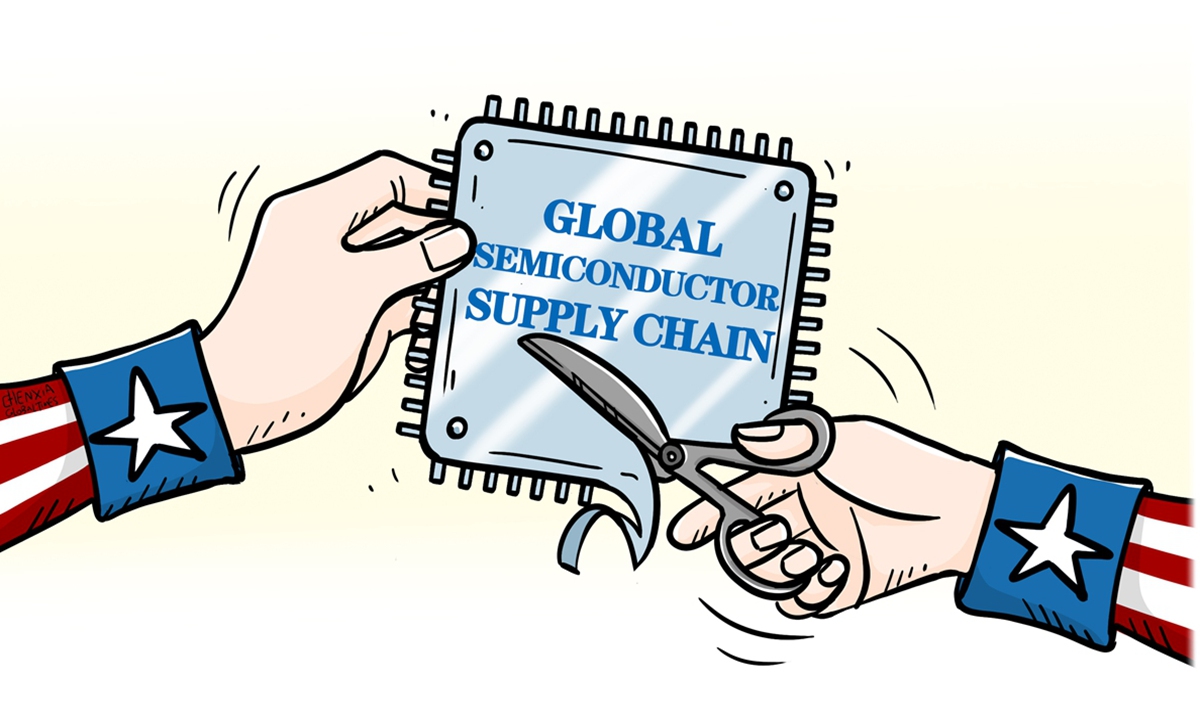China must play to its strengths to resist US chip coercion

Illustration: Chen Xia/GT
US President Joe Biden signed the CHIPS and Science Act on Tuesday, and anyone who knows anything about this bill will realize that it is a very specific industrial policy aim to make the US strong again.
What does Washington want? Not only does it seek the US control of high-end chips, but also to build the industrial base of a superpower with first-class competitiveness in many fields such as cutting-edge technology, research and human resources in the world.
For many years, the US has not introduced such a large-scale, all-of-nation development strategy. As a journalist concerned about US-China relations, what I see is that the chips are just a lead-in to the story, while the rest of the story will have a strategic tendency to position China as an adversary.
The bill contains a clear intent to exclude China from international industrial and technological cooperation, the standard-setting system, and the supply chain of high-tech products. The bill explicitly prohibits US companies that receive development support from investing in China's related infrastructure.
On one hand, the US will accelerate the return of industries through the combined efforts of the political and business communities, revitalize local research and production capabilities guided by semiconductor manufacturing, and strive to reduce dependence on overseas semiconductor supply chains, so that US companies can maintain control of the top end of the global industrial chain.
On the other, the US is actively building a semiconductor industry alliance that excludes China through state-led economic, diplomatic, trade and technology cooperation. The US will use the regrouping of allies to expand the radiation of its industrial power, both to secure its own supply chain and its share of the global market, and to squeeze the global cooperation and development space for made-in-China, especially high-end technologies and products.
In the course of the bill's development, the Biden administration and its top Democrats continued to emphasize that "China is our major competitor" and that the US must focus the nation's efforts on competing with China.
On the surface, it appears that Washington is using a rival to motivate the US to develop itself, as it has done in the past. However, since the competition the White House is talking about has from the beginning included uniting all allied forces from all levels and directions to besiege China, this bill is not only about the re-emergence of the superpower, but also about keeping the rise of China at bay. This is not a race on two runways, but a race to squeeze the opponent out on the same runway.
With the debate of this bill, a dark cloud of perception of China as an enemy is constantly being added to the sky over Washington. The recent visit of House Speaker Pelosi to Taiwan was also part of the combination of punches against China.
One of the reasons why Pelosi would intentionally use the Taiwan question to create a storm of public opinion is to create an atmosphere for the passage of the bill.
Creating tensions in the Taiwan Straits will not only further push regional allies closer to the US, but also interfere with the mainland's current domestic strategic deployment focused on its economy and improving its national strength.
As the bill is implemented, the US will make many other moves against China, but all changes will be the same: Washington will do its best to squeeze China's living space in the global research development and market system, and block the path of Chinese manufacturing and capital to high-end development and the global market.
Although China has sensed the strategic direction that Washington is forcing Beijing to be the enemy, it still needs to truly recognize what are the key targets of the US attacks.
The US is attacking China's strengths in its development, its all-encompassing, large-scale made-in-China, its high-technology represented by artificial intelligence and 5G, its expansion into the global market, and its advancement into the industrial standards system.
For China, it is imperative that we follow our strategic arrangement, handle our priorities and break through with our strengths.
How to better play the advantages of the national system is the key for China to break through the containment and suppression in this competition.
China needs to not only accelerate the pace of self-reliance in advancing scientific research and innovation, but also construct a system of foreign cooperation in key industries and scientific research through further opening up. The dual circulation has to come alive, and it will take both internal and external legs to accelerate.
The US has the high-end equipment and R&D capabilities to engage in chip alliances. We have the market and a large-scale, all-round manufacturing system, and can also engage in cooperation in key industries. The more the US tries to squeeze China out of the industrial chain, the more we need to improve our ability to bond with the global industrial chain. At the same time, China also needs to use the power of the country to promote Chinese technology, Chinese standards, and made-in-China to the world.
The author is a senior editor with People's Daily, and currently a senior fellow with the Chongyang Institute for Financial Studies at Renmin University of China. dinggang@globaltimes.com.cn. Follow him on Twitter @dinggangchina


